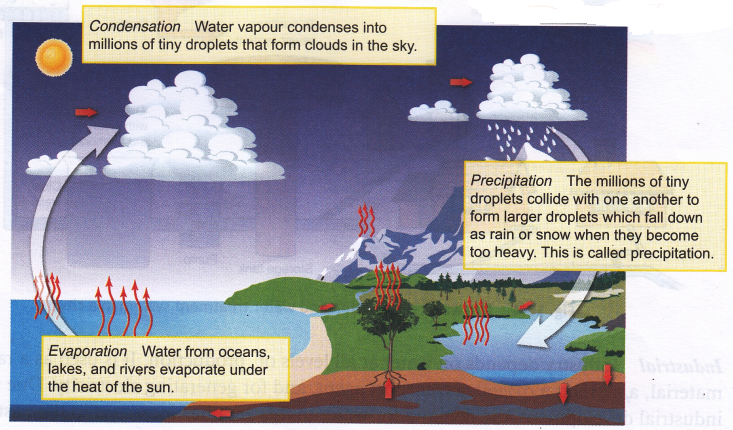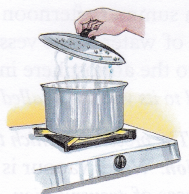Different Forms Of Water On Earth
Water is a natural resource that is vital to the presence of life on Earth. Water exists in abundance on our planet Earth. However, only a very small fraction of it is fit for human consumption. Let us first understand the distribution of water on Earth. Study the pie chart given below.
Where is most of the water on Earth found?
About three-fourth of the Earth’s surface is covered with water. That is why it is also called the water planet. But do you know how much water is readily available for use? Most of the water (about 97%) is in the seas and oceans as salt water. This water is too salty to be used for drinking and irrigation. Thus, only a tiny fraction (about 3%) of the Earth’s water is available to us as freshwater. Out of this, 2.997% is locked up in the mountains or glaciers or is buried so deep under that it costs too much to extract. So, only about 0.003% of the fresh water is easily available to us in the form of groundwater, river, lake, stream, soil moisture, and water vapour.

Most of the water that exists on Earth is in the seas and oceans. Sea and ocean water is highly salty and hence unfit for drinking. Most of the fresh water is frozen in the glaciers and in the polar ice caps, and is thus not readily available. Only a small fraction of fresh water is readily available for use. Therefore, all of us must make an effort to use water judiciously.
FORMS OF WATER
In nature, water exists in three states. It could be in the form of liquid (e.g., rain, river, sea), solid (e.g., ice, snow, hail), or gas (e.g., water vapour).
You can heat water over a stove to convert it into vapour. What happens if you leave water in an uncovered vessel on a summer afternoon outside your house? After a few hours, you will find that the level of water in the vessel has decreased. This is because a lot of it would have escaped into the atmosphere in the form of water vapour. The process by which a liquid is converted to its vapour is called evaporation.
What about the reverse process? The process by which the vapour of a substance is converted to its liquidform is called condensation. Water vapour is also added into the air by the leaves of plants, through the process of transpiration. Evaporation and condensation of water take place on a very large scale on the surface of the Earth and its atmosphere. These processes play a key role in cloud formation and rain.

All the three states of water are also present in our natural environment at any given time.
Solid: Glaciers, icebergs, snow, hail, frost, and ice crystals in the clouds are solid forms of water.
Liquid: Rain, dew, and clouds are water droplets or liquid forms of water. Liquid water also covers three-quarters of the surface of the Earth in the form of lakes, rivers, and oceans.
Gaseous: Water vapour, fog, steam, and clouds are gaseous forms of water. Water exists in all the three states because water can change its state very easily in a range of temperatures, i.e., between 0°C (ice) and 100°C (vapour). This change also takes place on its own in our environment forming a cycle which we know as the water cycle.
WATER CYCLE
Water droplets in the clouds keep bumping against one another, and sometimes stick to form bigger drops. When these drops become too heavy to float in the air, they drop down back to the Earth as rain. The water that comes down as rain, in time, evaporates and goes up to form clouds again. This leads to form a cycle, known as the water cycle. It is also called the hydrological cycle. Water cycle is the cyclic movement of water from the atmosphere to the Earth and back to the atmosphere through various processes.

CLOUD FORMATION
When the temperature of air increases, it expands (i.e., its particles move away from one another). This makes the air lighter and it rises in the atmosphere, taking water vapour with it. As the air rises, it begins to cool. The water vapour condenses on dust particles present in the atmosphere to form millions of tiny droplets. Tiny ice crystals will be formed instead if it is very cold. This cluster of tiny water droplets floating in air is what we call a cloud.
Activity
Aim: To observe condensation of water.
Materials needed: A glass or metal tumbler, ice-cold water and a handkerchief
Method:
- Take the tumbler and wipe it dry, both inside and outside.
- Pour ice-cold water into the tumbler.
- Wait for sometime and see what happens to the outer surface of the tumbler.
Observation: You will find that the outer surface of the tumbler becomes foggy with water droplets on it.
Conclusion: This is because water vapour in the atmosphere condenses on the cold surface of the tumbler.
Aim: To demonstrate condensation of steam.
Materials needed: A vessel with boiling water and a metal lid.
Method:
- Ask an adult to boil some water in a vessel and carefully place the vessel on a table.
- Hold the lid on top of the vessel so that the steam coming from the water touches it.

Observation: After a short while, you will find that the side of the lid facing the steam will have droplets of water.
Conclusion: This is because steam from the water condenses on the metal lid. The same can be done by holding a spoon over a steaming cup of water, tea, or coffee.